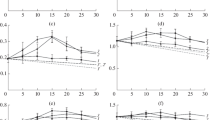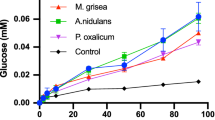Abstract
Although fractionation studies performed on the cellulases of the fungiPencillium funiculosum, Trichoderma koningii, andFusarium solani have shown that the solubilization of high ordered crystalline cellulose can be effected by mixtures of endo-1,4-Β-glucanase, cellobiohydrolase, and Β-glucosidase, factors that affect the interaction of these enzymes are not well understood. Sequential action between endo-1,4-Β-glucanase and cellobiohydrolase is almost certainly a feature of these cellulase systems, but experimental observations would suggest that it is not possible to discuss the mechanism purely in these terms. Some of the steric problems confronting the enzymes may explain, in part, many of the anomalous observations recorded.
The cellulase ofP. funiculosum is of special interest in that, in addition to four endo-1,4-Β-glucanases and two Β-glucosidases, it contains two cellobiohydrolases and a glucohydrolase. A detailed study of all these enzymes has not yet been carried out, but several properties of the glucohydrolase and cellobiohydrolase are worthy of note.
The glucohydrolase, in being strongly inhibited by glucono-1,5-lactone, in possessing transferase activity and in exhibiting activity on all other Β-linked, glucose disaccharides, had several properties normally associated with Β-glucosidases. It could be distinguished from the Β-glucosidases, however, in retaining anomeric configuration during hydrolysis and in being able to attack long glucan chains. The glucohydrolase was unable to cooperate with the endo- 1,4-Β-glucanase in solubilizing cotton cellulose and this contrasts with the high degree of cooperation shown by the cellobiohydrolase and endo-l,4-Β-glucanase in effecting the extensive solubilization of this substrate. The observation that an enzyme that removes two glucose units (cellobiohydrolase) from the end of the cellulose chain can act synergistically with the endo-l,4-Β-glucanase, but an enzyme that removes only one (glucohydrolase) cannot, must be connected in some way with steric rigidity of the anhydroglucose unit in the cellulose crystallite and the fact that cellobiose is the repeating unit.
Recently, studies have been extended to the two cellobiohydrolases ofP. funiculosum. Not surprisingly, it was found that the cellobiohydrolase enzymes had no capacity for cooperating to solubilize cotton cellulose. However, it was unexpected to find that they acted synergistically in degrading the microcrystalline cellulose, Avicel. Two immunologically unrelated cellobiohydrolases have been found recently in cultures of the fungusTrichoderma reesei. Experiments are now in progress to determine whether the two cellobiohydrolases ofP. funiculosum are also immunologically different. However, even if the cellobiohydrolases prove to be merely isoenzymes, the observation with Avicel is an unusual one.
It has already been observed that the cellobiohydrolase of one fungus can act synergistically with the endo-1,4-Β-glucanase of another in solubilizing highly ordered cellulose. However, when fungal cellobiohydrolases were added to the endo-1,4-Β-glucanase of the rumen bacteriaRuminococcus albus,Ruminococcus flavefaciens, andBacteroides succinogenes, no synergism was observed. One interpretation of this would be that these bacteria use mechanisms of cellulase action different from that used in the fungi.
Similar content being viewed by others
Author information
Authors and Affiliations
Rights and permissions
About this article
Cite this article
Wood, T.M., McCrae, S.I. & Wilson, C.A. Observations on the complex interactions involved in the enzymatic hydrolysis of cellulose. Appl Biochem Biotechnol 9, 313–314 (1984). https://doi.org/10.1007/BF02798952
Issue Date:
DOI: https://doi.org/10.1007/BF02798952




